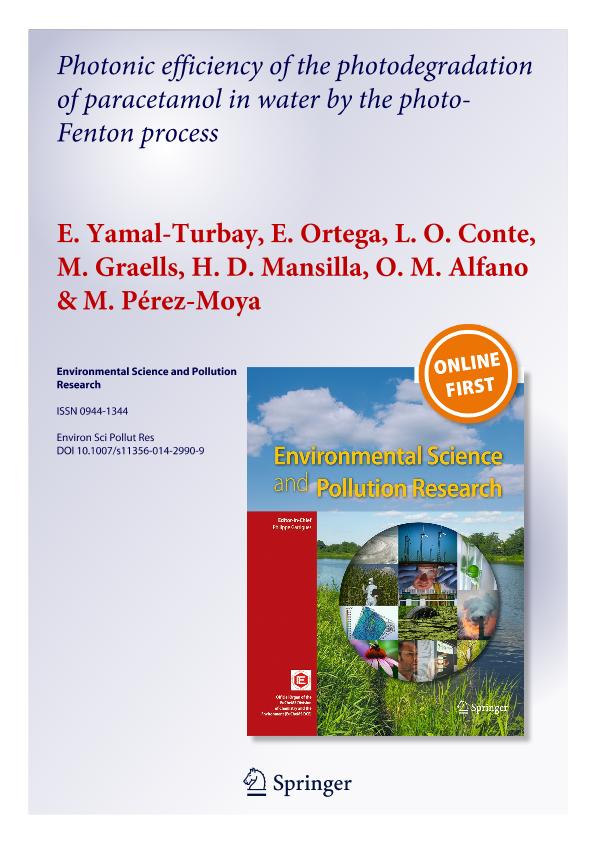Mostrar el registro sencillo del ítem
dc.contributor.author
Yamal Turbay, E.
dc.contributor.author
Ortega, E.
dc.contributor.author
Conte, Leandro Oscar

dc.contributor.author
Graells, M.
dc.contributor.author
Mansilla, H. D.
dc.contributor.author
Alfano, Orlando Mario

dc.contributor.author
Perez Moya, M.
dc.date.available
2016-12-26T14:04:20Z
dc.date.issued
2015-01
dc.identifier.citation
Yamal Turbay, E.; Ortega, E.; Conte, Leandro Oscar; Graells, M.; Mansilla, H. D.; et al.; Photonic Efficiency of the Photodegradation of Paracetamol in Water by the Photo-Fenton Process; Springer Heidelberg; Environmental Science And Pollution Research; 22; 2; 1-2015; 938-945
dc.identifier.issn
0944-1344
dc.identifier.uri
http://hdl.handle.net/11336/10060
dc.description.abstract
An experimental study of the homogeneous Fenton and photo-Fenton degradation of 4-amidophenol (paracetamol, PCT) is presented. For all the operation conditions evaluated, PCT degradation is efficiently attained by both Fenton and photo-Fenton processes. Also, photonic efficiencies of PCT degradation and mineralization are determined under different experimental conditions, characterizing the influence of hydrogen peroxide (H2O2) and Fe(II) on both contaminant degradation and sample mineralization. The maximum photonic degradation efficiencies for 5 and 10 mg L−1 Fe(II) were 3.9 (H2O2=189 mg L−1) and 5 (H2O2=378 mg L−1), respectively. For higher concentrations of oxidant, H2O2 acts as a "scavenger" radical, competing in pollutant degradation and reducing the reaction rate. Moreover, in order to quantify the consumption of the oxidizing agent, the specific consumption of the hydrogen peroxide was also evaluated. For all operating conditions of both hydrogen peroxide and Fe(II) concentration, the consumption values obtained for Fenton process were always higher than the corresponding values observed for photo-Fenton. This implies a less efficient use of the oxidizing agent for dark conditions.
dc.format
application/pdf
dc.language.iso
eng
dc.publisher
Springer Heidelberg

dc.rights
info:eu-repo/semantics/openAccess
dc.rights.uri
https://creativecommons.org/licenses/by-nc-sa/2.5/ar/
dc.subject
Photonic Efficiency
dc.subject
Paracetamol Degradation
dc.subject
Photo-Fenton
dc.subject
Emerging Contaminants
dc.subject.classification
Ingeniería de Procesos Químicos

dc.subject.classification
Ingeniería Química

dc.subject.classification
INGENIERÍAS Y TECNOLOGÍAS

dc.title
Photonic Efficiency of the Photodegradation of Paracetamol in Water by the Photo-Fenton Process
dc.type
info:eu-repo/semantics/article
dc.type
info:ar-repo/semantics/artículo
dc.type
info:eu-repo/semantics/publishedVersion
dc.date.updated
2016-12-16T14:24:32Z
dc.journal.volume
22
dc.journal.number
2
dc.journal.pagination
938-945
dc.journal.pais
Alemania

dc.journal.ciudad
Heidelberg
dc.description.fil
Fil: Yamal Turbay, E.. Escola Universitària Denginyeria Tècnica Industrial; España
dc.description.fil
Fil: Ortega, E.. Escola Universitària Denginyeria Tècnica Industrial; España
dc.description.fil
Fil: Conte, Leandro Oscar. Consejo Nacional de Investigaciones Científicas y Técnicas. Centro Científico Tecnológico Santa Fe. Instituto de Desarrollo Tecnológico Para la Industria Química (i); Argentina
dc.description.fil
Fil: Graells, M.. Escola Universitària Denginyeria Tècnica Industrial; España
dc.description.fil
Fil: Mansilla, H. D.. Universidad de Concepción; Chile
dc.description.fil
Fil: Alfano, Orlando Mario. Consejo Nacional de Investigaciones Científicas y Técnicas. Centro Científico Tecnológico Santa Fe. Instituto de Desarrollo Tecnológico Para la Industria Química (i); Argentina
dc.description.fil
Fil: Perez Moya, M.. Escola Universitària Denginyeria Tècnica Industrial; España
dc.journal.title
Environmental Science And Pollution Research

dc.relation.alternativeid
info:eu-repo/semantics/altIdentifier/doi/http://dx.doi.org/10.1007/s11356-014-2990-9
dc.relation.alternativeid
info:eu-repo/semantics/altIdentifier/url/http://link.springer.com/article/10.1007%2Fs11356-014-2990-9
Archivos asociados
